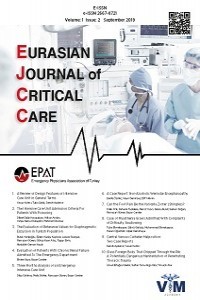A Comparison of The Modified Sad Persons Scale with Psychiatric Recommendations for Deciding On Hospitalization In Patients Admitted To Ed Due To Suicide
A Comparison of The Modified Sad Persons Scale with Psychiatric Recommendations for Deciding On Hospitalization In Patients Admitted To Ed Due To Suicide
Suicide, Modified Sadpersons Scale, Emergency Service,
___
- Organization WH. Suicide in the world: global health estimates. World Health Organization, 2019.
- Mgaya E, Kazaura MR, OutwaterA, Kinabo L. Suicide in the Dar es Salaam region, Tanzania, 2005. Journal of forensic and legal medicine. 2008;15(3):172-6.
- Coskun M, Zoroglu S, Ghaziuddin N. Suicide rates among Turkish and American youth: a cross-cultural comparison. Archives of suicide research. 2012;16(1):59-72.
- Demirel B, Akar T, SayinA, Candansayar S, Leenaars AA. Farewell to the world: Suicide notes from Turkey. Suicide and Life-Threatening Behavior. 2008;38(1):122-7.
- Hockberger RS, Rothstein RJ. Assessment of suicide potential by nonpsychiatrists using the SAD PERSONS score. The Journal of emergency medicine. 1988;6(2):99-107.
- Turecki G, Brent DA, Gunnell D, O’Connor RC, Oquendo MA, Pirkis J, et al. Suicide and suicide risk. Nature reviews Disease primers. 2019;5(1):1-22.
- Windfuhr K, While D, Kapur N, Ashcroft DM, Kontopantelis E, Carr MJ, et al. Suicide risk linked with clinical consultation frequency, psychiatric diagnoses and psychotropic medication prescribing in a national study of primary-care patients. Psychological medicine. 2016;46(16):3407-17.
- Nishi M, Miyake H, Okamoto H, Goto Y, Sakai T. Relationship Between Suicide and Holidays. Journal of Epidemiology. 2000;10(5):317-20.
- Brådvik L. The occurrence of suicide in severe depression related to the months of the year and the days of the week. European archives of psychiatry and clinical neuroscience. 2002;252(1):28-32.
- Patterson WM, Dohn HH, Bird J, Patterson GA. Evaluation of suicidal patients: the SAD PERSONS scale. Psychosomatics. 1983;24(4):343-9.
- Katz C, Randall JR, Sareen J, Chateau D, Walld R, Leslie WD, et al. Predicting suicide with the SAD PERSONS scale. Depression and anxiety. 2017;34(9):809-16.
- Cochrane-Brink KA, Lofchy JS, Sakinofsky I. Clinical rating scales in suicide risk assessment. General hospital psychiatry. 2000;22(6):445-52.
- Başlangıç: 2019
- Yayıncı: Acil Tıp Uzmanları Derneği
Prognostic Value of the Systemic Immune-Inflammation Index in Acute Pulmonary Embolism
Evaluation of Post-Discharge Attitudes and Behaviors of Patients Affected by The COVİD-19 Pandemic
Gokhan TANSEL, Bahadir TASLİDERE, Bilgehan DEMİR, Özcan ERDOĞAN
Broca’s Aphasia Caused by Hemorrhagic Stroke in a Young Patient: A Case Report
Furkan GEDİKLİOGLU, Melike KARACABAY, Yasemin PİSGİN, Bahadir TASLİDERE
Case Report with Non-Traumatic Hemoragic SVO and Spontaneous Pneumothorax
Ömer Faruk KÜÇÜK, Hakan HAKKOYMAZ, Muhammet Mustafa YILMAZ, Bedirhan ÖZDEMİR, Muhammed ALKAYA, Caner AKUFUK, Ali İhsan KİLCİ
Ahmet Burhan DOGAN, Bahadir TASLİDERE
Giant Cervical Tuberculous Lymphadenitis: Case Report
Oya GÜVEN, Lale TUNA, Süleyman Hilmi KONAR, Leyla PASAYEVA, Bedriye Feyza KURT
Mehmet TATLI, Gökhan EYÜPOĞLU, Özlem GÜNEYSEL, Hilal HOCAGİL, Hakan HAKKOYMAZ, Muhammed Semih GEDİK
General Approach to Cases of Drug Intoxication
Muhammed Semih GEDİK, Hakan HAKKOYMAZ, Ali İhsan KİLCİ, Ömer Faruk KÜÇÜK
Charcot Arthropathy and Osteomyelitis: A Case of Diabetic Foot Syndrome
Hasiba KARİMİ, Ali Osman BALKAN, Derya AKBABA, Gizem YİLMAZ, Ömer Faruk ÇAKIROĞLU, Basar CANDER
